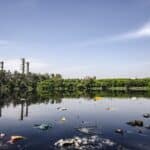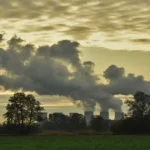Land pollution is a growing environmental concern that directly affects ecosystems, public health, and community well-being. It occurs when harmful substances contaminate the soil, reducing its quality and usability. These pollutants negatively impact plants, animals, and humans alike.
Understanding land pollution is essential because it influences the food we consume, the water we rely on, and the overall balance of nature. This informational guide explores what land pollution is, its primary causes, its effects, and practical solutions.
By increasing awareness, we can take meaningful steps to protect the land and ensure a healthier environment for present and future generations.
What Is Land Pollution
Land pollution refers to the degradation of the earth’s surface caused by the presence of harmful substances in the soil. These substances reduce land quality and limit its ability to support plants, animals, and human activities.
Unlike temporary surface waste, land pollution often leads to long-lasting damage because contaminants remain in the soil for many years.
Understanding what land pollution is helps explain why protecting soil health is essential for food security, clean water, and ecological balance.
Definition and Meaning of Land Pollution
Land pollution is the contamination of soil by waste materials, chemicals, and toxic substances. It occurs when harmful elements are introduced into the ground faster than nature can break them down.
These pollutants may come from industrial waste, agricultural chemicals, or improperly disposed household waste.
As contamination builds up, soil loses its natural nutrients and structure. This makes the land less fertile and unsafe for growing crops or supporting wildlife.
Over time, polluted soil can also affect nearby water sources and enter the food chain, creating wider environmental and health problems.
How Land Pollution Differs from Air and Water Pollution
Land pollution differs from air and water pollution in both location and impact. Air pollution affects the atmosphere and spreads quickly through wind, while water pollution contaminates rivers, lakes, and oceans.
In contrast, land pollution is concentrated in the soil and often remains in one place for long periods.
Because soil pollution is less visible, it can go unnoticed for years. However, its effects are persistent. Pollutants stored in soil slowly release toxins into crops, groundwater, and ecosystems.
This long-term nature makes land pollution more difficult to reverse compared to air or water pollution.
Historical Background of Land Pollution
The problem of land pollution began to grow during the early stages of industrialization. In the nineteenth century, factories produced large amounts of waste that were often dumped directly onto land without treatment.
Mining activities also left behind harmful residues that contaminated surrounding soil.
As cities expanded, urban growth increased the volume of solid waste. At the same time, modern agriculture introduced chemical fertilizers and pesticides to boost crop production. While these methods improved yields, they also added pollutants to the soil.
Over the years, these combined activities have made land pollution a major environmental challenge that continues to affect soil health worldwide.
Causes of Land Pollution
Land pollution results from various human activities that introduce harmful substances into the soil. These activities degrade the land, making it less fertile and more toxic for living organisms. Understanding the causes of land pollution is essential to finding effective solutions.
Industrial Activities
Industries play a significant role in land pollution. Factories release chemicals, heavy metals, and toxic waste into the environment. For example, mining operations can leave behind harmful substances like mercury and lead.
These pollutants contaminate the soil, harming plants, animals, and even humans who rely on the land.
Agricultural Practices
Agriculture also contributes to land pollution. The excessive use of chemical fertilizers and pesticides can lead to soil contamination. For instance, when farmers use these chemicals to increase crop yields, they may seep into the ground, reducing soil fertility. Over time, this practice can lead to long-term damage to the land.
Urbanization and Construction
Urbanization and construction are other major contributors to land pollution. As cities expand, natural areas are converted into residential and commercial spaces.
Construction activities often involve clearing land, which can lead to soil erosion. Additionally, building materials and waste from construction sites can pollute the land.
Improper Waste Disposal and Landfills
Improper waste disposal is a leading cause of land pollution. When trash is not disposed of properly, it accumulates on the land, creating dumpsites. These sites often contain non-biodegradable materials like plastic, which can take hundreds of years to break down.
This waste can release harmful chemicals into the soil, affecting its quality and health. Human activities are at the core of land pollution, making it vital to change our practices to protect the environment.
Also Read: Ecology, Environment, and Conservation Strategies
Effects of Land Pollution
Land pollution has wide-ranging effects that impact not only the environment but also human health and wildlife. The degradation of soil quality can lead to reduced agricultural productivity, while the presence of toxins in the soil poses risks to both humans and animals.
Understanding these effects is crucial for taking action to mitigate the damage.
Environmental Impact
Land pollution disrupts ecosystems by contaminating the soil and water sources. Pollutants like chemicals, heavy metals, and waste materials can alter the natural balance of nutrients in the soil.
This contamination can lead to reduced plant growth and biodiversity loss. Soil erosion, another consequence, can result in barren land, making it difficult for vegetation to grow.
Effects on Human Health
Land pollution poses significant risks to human health. Contaminated soil can affect the food chain, as crops grown in polluted soil may absorb harmful substances. When consumed, these toxins can cause various health issues, including cancer, respiratory problems, and skin diseases.
Additionally, polluted land near residential areas can lead to an increased incidence of illnesses due to direct exposure to hazardous materials.
Impact on Wildlife and Natural Habitats
Wildlife and natural habitats are also severely affected by land pollution. Animals may ingest or absorb toxins from polluted soil, leading to health problems or death. Polluted habitats can force wildlife to migrate, disrupting ecosystems.
Over time, this can lead to the extinction of species that are unable to adapt to the changing environment.
The long-term consequences of unchecked land pollution are dire. Continued contamination can lead to the irreversible loss of fertile land, making it unsuitable for agriculture or habitation.
This can contribute to food shortages and the displacement of communities, highlighting the urgent need for effective land management practices.
Prevention and Control of Land Pollution
Controlling land pollution requires a comprehensive approach that includes prevention, effective management, and strong policies. By addressing the root causes and implementing practical solutions, we can reduce the impact of land pollution and protect our environment.
Sustainable Farming Practices
Sustainable farming is essential for preventing land pollution. Farmers can adopt practices like crop rotation, organic farming, and reduced use of chemical fertilizers. These methods help maintain soil health and reduce the risk of contamination.
For example, organic farming avoids synthetic chemicals, promoting a healthier environment. By focusing on soil conservation and natural pest control, sustainable farming minimizes pollution while maintaining productivity.
Waste Management Solutions
Proper waste management is crucial in controlling land pollution. This includes reducing, reusing, and recycling waste from homes and industries. For instance, households can separate recyclable materials from general waste, reducing the amount sent to landfills.
Industries can invest in technologies that reduce hazardous waste and ensure safe disposal. Composting organic waste at home is another effective way to reduce land pollution. Implementing these strategies helps prevent the accumulation of harmful materials in the soil.
Policies and Regulations
Government policies and regulations play a vital role in preventing land pollution. Regulations can enforce proper waste disposal practices, limit the use of harmful chemicals, and promote sustainable land use.
For example, laws requiring industries to treat their waste before disposal help reduce soil contamination. Governments can also support programs that encourage sustainable farming and waste management.
Individual and collective actions are key to successfully controlling land pollution. By making informed choices and advocating for better practices, everyone can contribute to a cleaner, healthier environment.
Communities can work together to implement local initiatives, while individuals can reduce their waste footprint by guiding each other for proper waste disposal, supporting global efforts to prevent land pollution.
The Future of Land Pollution
If current trends in land pollution continue, the future looks bleak. We could face widespread soil degradation, reduced agricultural productivity, and irreversible damage to ecosystems. This would lead to food shortages, displacement of communities, and loss of biodiversity.
However, there is hope. Emerging solutions like bioremediation, where living organisms are used to clean contaminated soil, offer promising results. Innovations in waste management, such as zero-waste systems and advanced recycling technologies, are also gaining traction.
These solutions can significantly reduce the impact of land pollution if widely adopted. It’s crucial for everyone to take action now. By making conscious choices and supporting sustainable practices, we can help protect the land for future generations. The time to act is now, and every small effort counts.
Conclusion
Land pollution is a significant issue with wide-ranging effects on the environment, human health, and wildlife. The causes include industrial activities, agricultural practices, urbanization, and improper waste disposal. These contribute to soil contamination and long-term damage.
Addressing land pollution is crucial for ensuring a healthy planet and sustainable future. Emerging solutions and better waste management practices offer hope, but immediate action is necessary. Staying informed and adopting environmentally friendly practices can make a difference.
By recognizing the importance of this issue, everyone can contribute to reducing land pollution and protecting the earth for future generations. The future of our environment depends on the choices made today.






